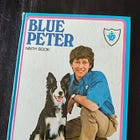The Princess's Present
BIT OF HISTORY Random Stuff From Annette's Collection: A Crowdfunded Royal Gift for Millions
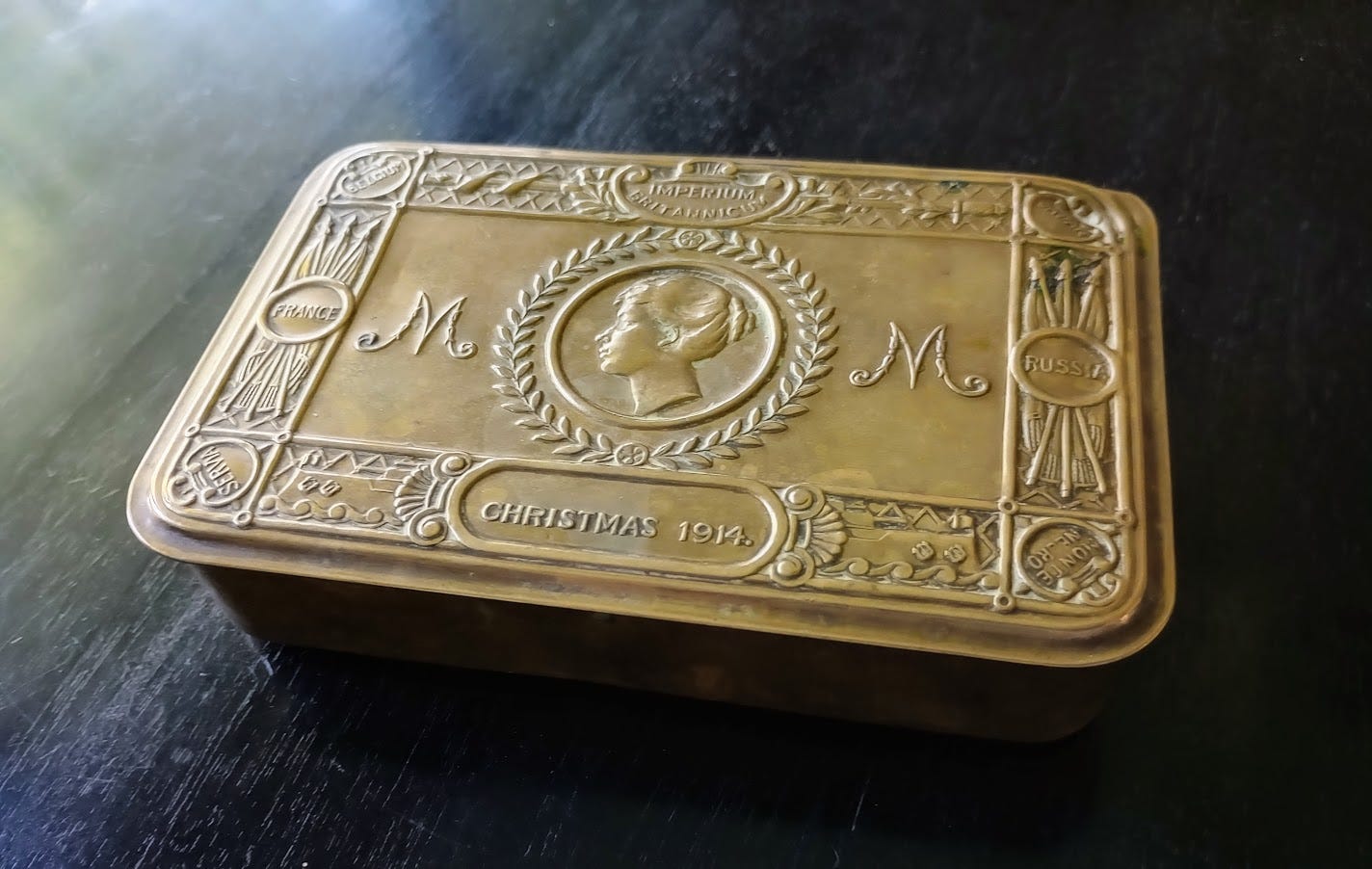
"I want you now to help me to send a Christmas present from the whole of the nation to every sailor afloat and every soldier at the front.
— Britain’s Princess Mary, age 17, 1914
How Long Is This Post? About 3000 words, or 15 minutes
Note from Annette: Shopping on Diagon Alley
I don’t remember when I found this object exactly, maybe eight or ten years ago, but I do remember where: I was back in London, window-shopping on Cecil Court.
Cecil Court is a short pedestrian street, more an alley than a court, despite its name. Lined with antiquarian bookshops and antique stores, it’s reputedly the inspiration (or one of them) for Diagon Alley, the wizard shopping mall in J.K. Rowling’s Harry Potter books.
Something in an antique shop window caught my eye. Specifically, the brass tin in the photo above.
Oooh! I had never seen one of these in the flesh, not even a reproduction! And it cost . . . £100! Which was (wild guess) about $140 at the time.
Had this knick-knack only appealed for my own enjoyment, the story would have ended there. As an antique collector, I’m a very low roller.
But it wasn't for me. I was putting together my in-school presentation/author talk thingy on World War I, to go with my novels, two of which connect to the Great War, and I needed props to show the kids.
This tin got me all excited because I’ve been fascinated by Royal gift tins for British troops (which is what this is) almost all my life.
That sounds weird, but I can explain! As a kid, I watched an episode of BBC’s Blue Peter that was all about the original soldiers’ Xmas gift tin. Queen Victoria sent it in 1900 to soldiers fighting in the Boer War. It contained chocolate, much of which presumably arrived in South Africa as soup. Shiny object? Chocolate? Interested! And that interest extended to the gift tins the Royals sent to troops 14 years later, during World War One. Like this one.
But this time, it wasn't usually filled with chocolate.
What’s Blue Peter, what does it have to do with history education, and why could it matter to Americans now? Find out here, from this Bit of History post:
In triumph, I pushed open the door of that London shop, setting off the tinkling bell that announced “Dr. Laing is here to help you pay the rent, Mr. Antique Dealer!”, and rammed my credit card in his general direction,
Oh, dear. The following year, I found an identical tin for sale at a Second World War re-enactment weekend in the North of England. It cost £35, about one-third the price of my first tin. Sigh. I bought that one as a back-up tin. The one you see here, though, is the expensive London original, earning its keep. Lesson: Don’t shop for antiques in London.
More Antique Advice (Barbie Movie Edition)
Okay, for anyone, especially but not only young women, discovering an inner feminist after watching the Barbie movie (which I haven’t seen yet, despite my Sacramento connections and two degrees of separation from Greta Gerwig): Let me give you a useful tip for dealing with unpleasant antiques dealers from my very first solo shopping encounter with a London antiques dealer.
I was nineteen, and unaccompanied by a serious-looking older adult male shopper. I asked to see a little knick-knack from the window, thinking of it as a possible gift for an American friend who was an avid collector and a bit of an Anglophile.
“Are you a collector?” asked the dealer in an unmistakably snotty tone.
“No,” I said, “this is for a friend.”
“Does he collect these?”
“Oh, he collects everything,” I said pleasantly. That wasn’t far from the truth.
“Well,” said the dealer, sneering openly now, “this will be a proper little godsend for him, then, won’t it?”
I’m very proud of what I did next. I gave him a hard stare (thank you, British WWII ladies, like my teacher Mrs. Betty Seale, who taught me and Paddington Bear that trick), handed it back like a hot potato with a curt “Thank you”, and exited.
It took me about five minutes to stop shaking as I walked back down Piccadilly. I’m not courageous, as you may have figured out. Just influenced by Scary Old Bags. Now I’m a Scary Old Bag. Alas, that just makes me more eligible to be hanged as a witch. I prefer hanging in there.
Laing, Get On With It. So What Is This Thingy?
It’s one of many little tins made from heavy solid brass, and filled with useful gifty things, that was presented to everyone who served the British Empire during World War One. But, as we’ll see, that's not the most fun part of the story.
The top of the tin is embossed with Princess Mary’s head, her monogram on either side, the words Christmas, 1914. below. At top is the Latin for British Empire, and in each corner, the names of British allies in the War in 1914: Russia, France, and also little Montenegro and Servia, both in the Balkans.
Despite being teeny, these two got equal billing with France and Russia. During the war, Servia’s spelling in English was corrected to Serbia to make it sound less servile. That's interesting, because the word servile (and servant) comes from Servia, like the word slavery was derived from Slavs, who I don't think are ever called Slabs. Still, this word history gives you some idea of the historical state of human rights in that part of the world.
My tin, like all such tins that come up for sale, came empty, and no wonder: The gifts were perishable, and they were used, and the other contents were paper, fiddly, and easily lost. But because lots of World War I re-enactors want the whole set, I was able to buy a repro of the packaging of typical contents (no, there’s no tobacco or cigarettes in the packets!)
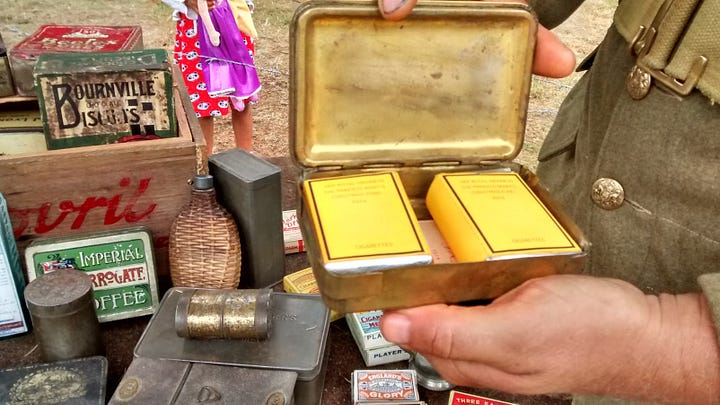
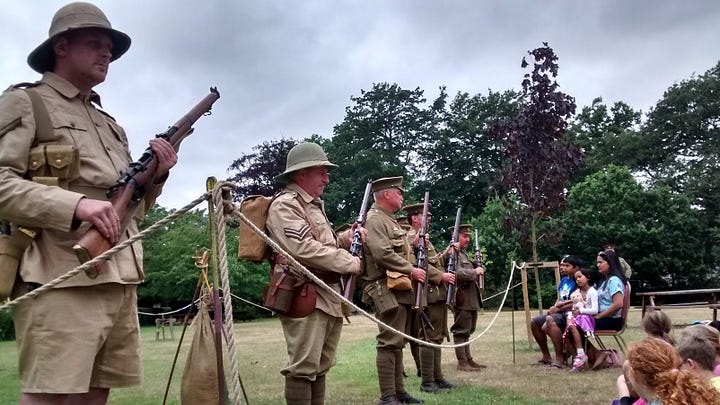
Here’s a photo of my tin and my fake contents:
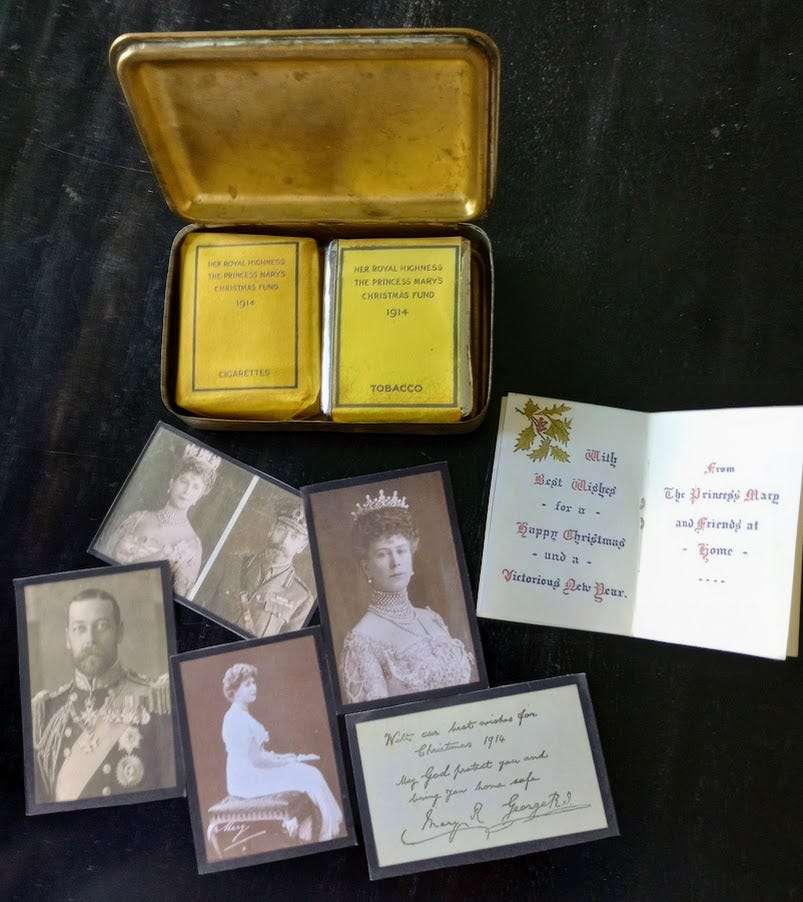
Included in most tins were a handwritten greeting from the King, wishing the recipient a happy Christmas. This seems overoptimistic, but a kind of happy Christmas actually happened for some soldiers in the trenches, when they had an unauthorized truce for the day, and sang carols and even played football with the Germans, before returning to killing each other the following day.
The King’s greeting also offers what seems now a second forlorn hope, given the horrendous battlefield casualties of the war: “May God protect you, and bring you home safe.”
I trust most soldiers appreciated the sentiment. By the time these tins were even thought of, in Autumn, 1914, while the truth didn’t start to dawn on the public until the following year, the Army was figuring out that this would be like no other war. A horrific bloodbath. One of my great-great uncles, like many in the regular Army, was already dead, killed in the first month of the war.
The box’s photos are of the King and Queen together, the King in Army uniform, the Queen (definitely not in Army uniform) and Princess Mary looking lovely, which was undoubtedly the most popular of the four.
There’s also a mini Christmas card from “The Princess Mary, and Friends at Home”. This didn't mean Princess Mary’s friends, but the public, who, as friends of the troops, had donated a small fortune to make this happen.
Little did anyone realize that these little tins would turn into one of the most challenging and successful operations of the War.
Operation Complicated Xmas (not actually its name)
In early October, 1914, two months after the First World War began, the story goes, Princess Mary, daughter of King George V and Queen Mary (King Charles III’s great-grandparents) had the idea of sending half a million troops and sailors a Christmas gift from her own pocket money.
I’m not buying that for reasons. Even Princess Mary didn’t have that much money, plus this wasn’t her original idea: Her great-granny, Queen Victoria, had sent the first royal gift tin to the troops of the Boer War, back in 1900. There was a meeting at Buckingham Palace early that month, attended by Queen Mary, the Princess’s mum, Prince Edward (the ill-fated future King Edward VIII, the one who married an American and almost brought down the monarchy, no, not him, the other one). Also present was Walter Peacock, one of Prince Edward’s staff, and I only mention him, because we’ll see him again. I guess Princess Mary was there, too, but it’s not clear to me that she was.
Anyway, voom, pow, this Royal group decides that the project is too expensive even for the Royals. I guess they learned something from the Boer War tins, which Queen Victoria paid for personally, at enormous expense, and probably had to mortgage one of the minor palaces to pay for it (okay, I made that last bit up).
One week later, a letter under the byline of Princess Mary, a winsome girl of 17, was published in newspapers. She appealed to the public for funds. I know, it sounds unlikely, but it's very possible she really did write it. It’s very cute. Here’s an excerpt:
"I want you now to help me to send a Christmas present from the whole of the nation to every sailor afloat and every soldier at the front. I am sure that we should all be happier to feel that we had helped to send our little token of love and sympathy on Christmas morning, something that would be useful and of permanent value, and the making of which may be the means of providing employment in trades adversely affected by the war. Could there be anything more likely to hearten them in their struggle than a present received straight from home on Christmas Day?
Please will you help me?"
See what I mean? The Princess’s appealing appeal set off a massive outpouring of generosity among ordinary Brits. Even kids donated £6,000 pounds in pennies, no small gift when a British penny bought a kid quite a lot of cheap candy: Even in my childhood, it got me a handful of toothrotting rubbish.
A little gift tin seems like a small thing, but it turned out to be an expensive logistical nightmare. And a triumph.




